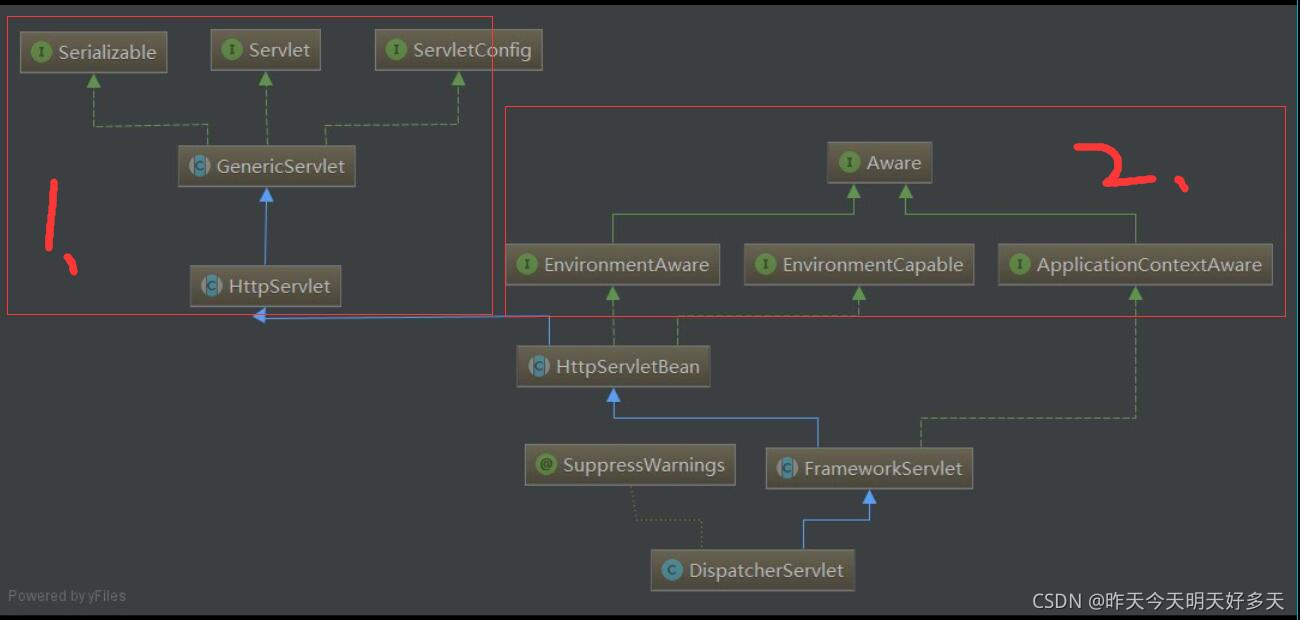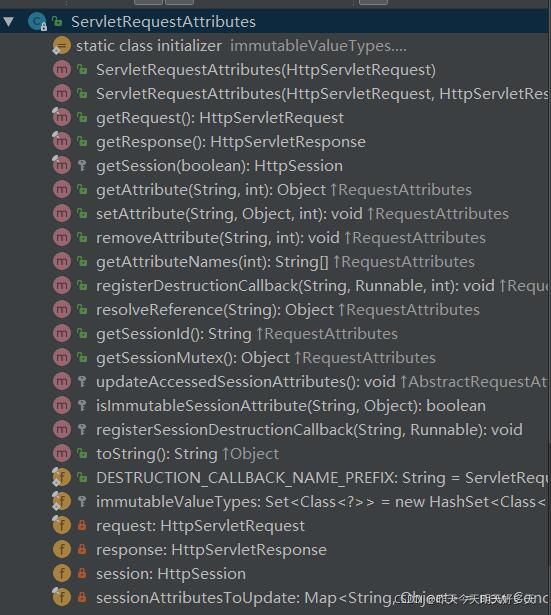RequestContextHolder
持有上下文的Request容器通过RequestContextHolder的静态方法可以随时随地取到当前请求的request对象//获取相关对象//底层实现//底层实现//或者转成具体对象。
一、概述
-
RequestContextHolder:持有上下文的Request容器
-
通过RequestContextHolder的静态方法可以随时随地取到当前请求的request对象
// 获取相关对象
RequestAttributes requestAttributes = RequestContextHolder.getRequestAttributes();// 底层实现:request.getAttribute(“userId”);
String userId = (String) requestAttributes.getAttribute(“userId”,RequestAttributes.SCOPE_REQUEST);// 底层实现:session.getAttribute(“userId”);
String userId = (String) requestAttributes.getAttribute(“userId”,RequestAttributes.SCOPE_SESSION);// 或者转成具体对象
HttpServletRequest request = ((ServletRequestAttributes) requestAttributes).getRequest();
HttpServletResponse response = ((ServletRequestAttributes) requestAttributes).getResponse();
HttpSession session = request.getSession();
二、RequestContextHolder 源码
public abstract class RequestContextHolder {
private static final boolean jsfPresent = ClassUtils.isPresent("javax.faces.context.FacesContext", RequestContextHolder.class.getClassLoader());
/** 得到存储进去的request */
private static final ThreadLocal<RequestAttributes> requestAttributesHolder = new NamedThreadLocal("Request attributes");
/** 可被子线程继承的request */
private static final ThreadLocal<RequestAttributes> inheritableRequestAttributesHolder = new NamedInheritableThreadLocal("Request context");
public RequestContextHolder() {
}
public static void resetRequestAttributes() {
requestAttributesHolder.remove();
inheritableRequestAttributesHolder.remove();
}
public static void setRequestAttributes(@Nullable RequestAttributes attributes) {
setRequestAttributes(attributes, false);
}
public static void setRequestAttributes(@Nullable RequestAttributes attributes, boolean inheritable) {
if (attributes == null) {
resetRequestAttributes();
} else if (inheritable) {
inheritableRequestAttributesHolder.set(attributes);
requestAttributesHolder.remove();
} else {
requestAttributesHolder.set(attributes);
inheritableRequestAttributesHolder.remove();
}
}
//直接获取ThreadLocal里面的值,这样就保证了每一次获取到的Request是该请求的request.
@Nullable
public static RequestAttributes getRequestAttributes() {
RequestAttributes attributes = (RequestAttributes)requestAttributesHolder.get();
if (attributes == null) {
attributes = (RequestAttributes)inheritableRequestAttributesHolder.get();
}
return attributes;
}
public static RequestAttributes currentRequestAttributes() throws IllegalStateException {
RequestAttributes attributes = getRequestAttributes();
if (attributes == null) {
if (jsfPresent) {
attributes = RequestContextHolder.FacesRequestAttributesFactory.getFacesRequestAttributes();
}
if (attributes == null) {
throw new IllegalStateException("No thread-bound request found: Are you referring to request attributes outside of an actual web request, or processing a request outside of the originally receiving thread? If you are actually operating within a web request and still receive this message, your code is probably running outside of DispatcherServlet: In this case, use RequestContextListener or RequestContextFilter to expose the current request.");
}
}
return attributes;
}
private static class FacesRequestAttributesFactory {
private FacesRequestAttributesFactory() {
}
@Nullable
public static RequestAttributes getFacesRequestAttributes() {
FacesContext facesContext = FacesContext.getCurrentInstance();
return facesContext != null ? new FacesRequestAttributes(facesContext) : null;
}
}
}
三、实现原理 ThreadLocal
ThreadLocal是一个本地线程副本变量工具类。主要用于将私有线程和该线程存放的副本对象做一个映射,各个线程之间的变量互不干扰,在高并发场景下,可以实现无状态的调用,特别适用于各个线程依赖不同的变量值完成操作的场景。
在每个线程的内部存在一个数据结构为Map的ThreadLocals变量,以<ThreadLocal,Value>的形式保存着线程变量和其对应的值。
对于不同的线程,每次获取副本值时,别的线程并不能获取到当前线程的副本值,形成了副本的隔离,互不干扰。

四、问题
1. request和response怎么和当前请求挂钩
getRequestAttributes():直接获取ThreadLocal里面的值,保证了每一次获取到的Request是该请求的request.
2. request和response等是什么时候设置进去的
DispatcherServlet继承关系:

- 1:Servlet的接口和实现类.
- 2:SpringMVC具有Spring的一些环境变量和Spring容器,类似的XXXAware接口就是对该类提供Spring感知,简单来说就是如果想使用Spring的XXXX就要实现XXXAware,spring会把需要的东西传送过来。
- HttpServletBean:进行初始化工作
- FrameworkServlet:初始化WebApplicationContext,并提供service方法预处理请求
- DispatcherServlet:具体分发处理
FrameworkServlet 类重写了service()、doGet()、doPost() 等方法,方法里面都有一个预处理方法 processRequest(request, response);
查看 processRequest(request, response) 的实现:获取上一个请求的参数 重新建立新的参数 设置到XXContextHolder 父类的service()处理请求 恢复request 发布事件
processRequest 源码
protected final void processRequest(HttpServletRequest request, HttpServletResponse response)
throws ServletException, IOException {
long startTime = System.currentTimeMillis();
Throwable failureCause = null;
//获取上一个请求保存的LocaleContext
LocaleContext previousLocaleContext = LocaleContextHolder.getLocaleContext();
//建立新的LocaleContext
LocaleContext localeContext = buildLocaleContext(request);
//获取上一个请求保存的RequestAttributes
RequestAttributes previousAttributes = RequestContextHolder.getRequestAttributes();
//建立新的RequestAttributes
ServletRequestAttributes requestAttributes = buildRequestAttributes(request, response, previousAttributes);
WebAsyncManager asyncManager = WebAsyncUtils.getAsyncManager(request);
asyncManager.registerCallableInterceptor(FrameworkServlet.class.getName(), new RequestBindingInterceptor());
//具体设置的方法
initContextHolders(request, localeContext, requestAttributes);
try {
doService(request, response);
}
catch (ServletException ex) {
failureCause = ex;
throw ex;
}
catch (IOException ex) {
failureCause = ex;
throw ex;
}
catch (Throwable ex) {
failureCause = ex;
throw new NestedServletException("Request processing failed", ex);
}
finally {
//恢复
resetContextHolders(request, previousLocaleContext, previousAttributes);
if (requestAttributes != null) {
requestAttributes.requestCompleted();
}
if (logger.isDebugEnabled()) {
if (failureCause != null) {
this.logger.debug("Could not complete request", failureCause);
}
else {
if (asyncManager.isConcurrentHandlingStarted()) {
logger.debug("Leaving response open for concurrent processing");
}
else {
this.logger.debug("Successfully completed request");
}
}
}
//发布事件
publishRequestHandledEvent(request, response, startTime, failureCause);
}
}
initContextHolders(request, localeContext, requestAttributes)
把新的RequestAttributes设置进LocalThread,实际上保存的类型为ServletRequestAttributes,这也是为什么在使用的时候可以把RequestAttributes强转为ServletRequestAttributes。
private void initContextHolders(
HttpServletRequest request, LocaleContext localeContext, RequestAttributes requestAttributes) {
if (localeContext != null) {
LocaleContextHolder.setLocaleContext(localeContext, this.threadContextInheritable);
}
if (requestAttributes != null) {
RequestContextHolder.setRequestAttributes(requestAttributes, this.threadContextInheritable);
}
if (logger.isTraceEnabled()) {
logger.trace("Bound request context to thread: " + request);
}
}
因此RequestContextHolder里面最终保存的为ServletRequestAttributes,这个类相比RequestAttributes方法是多了很多

五、参考
先自我介绍一下,小编13年上师交大毕业,曾经在小公司待过,去过华为OPPO等大厂,18年进入阿里,直到现在。深知大多数初中级java工程师,想要升技能,往往是需要自己摸索成长或是报班学习,但对于培训机构动则近万元的学费,着实压力不小。自己不成体系的自学效率很低又漫长,而且容易碰到天花板技术停止不前。因此我收集了一份《java开发全套学习资料》送给大家,初衷也很简单,就是希望帮助到想自学又不知道该从何学起的朋友,同时减轻大家的负担。添加下方名片,即可获取全套学习资料哦
更多推荐
 已为社区贡献8条内容
已为社区贡献8条内容









所有评论(0)